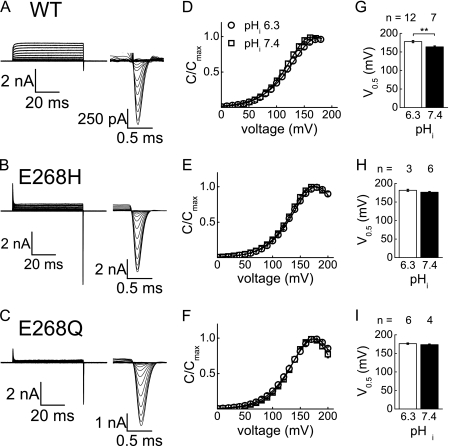FIGURE 4.
Gating charge movements and nonlinear capacitances of ClC-5. A–C, representative current recordings from WT ClC-5 and mutants E268H and E268Q in internal and external Cl− solutions at pH 7.4 at voltage steps from −115 to +165 mV. To eliminate linear capacitance peaks, p/N leak subtraction was applied. The insets depict enlarged gating charge movements at the end of the voltage pulses (off-charge). The mean ClC-5 currents at +165 mV were 2.9 ± 0.5 nA (pH 7.4) and 2.9 ± 0.8 nA (pH 6.3) for WT ClC-5, 0.8 ± 0.2 nA (pH 7.4) and 0.9 ± 0.2 nA (pH 6.3) for E268H ClC-5, and 0.2 ± 0.1 nA (pH 7.4) and 0.2 ± 0.1 nA (pH 6.3) for E268Q ClC-5. D–F, normalized nonlinear capacitances for WT, E268H, and E268Q ClC-5 at internal pH 6.3 and 7.4 and in external solution with reduced [Cl−] (500 μm, pH 7.4). Lines represent fits of the first derivative of a Boltzmann function (Equation 1) to the data with fit parameters shown in supplemental Table S1. Averaged maximum nonlinear capacitances at different internal pH values were 1.7 ± 0.3 pF (pH 6.3) and 3.8 ± 1.2 pF (pH 7.4) for WT ClC-5, 1.3 ± 0.6 pF (pH 6.3) and 8.2 ± 2.7 pF (pH 7.4) for E268H ClC-5, and 3.6 ± 0.7 pF (pH 6.3) and 2.6 ± 0.4 pF (pH 7.4) for E268Q ClC-5. G–I, mean half-maximum voltage of activation (V0.5; Equation 1) of WT, E268H, and E268Q ClC-5, respectively. Asterisks indicate significant difference from a two-sample t test: **, p < 0.01.

